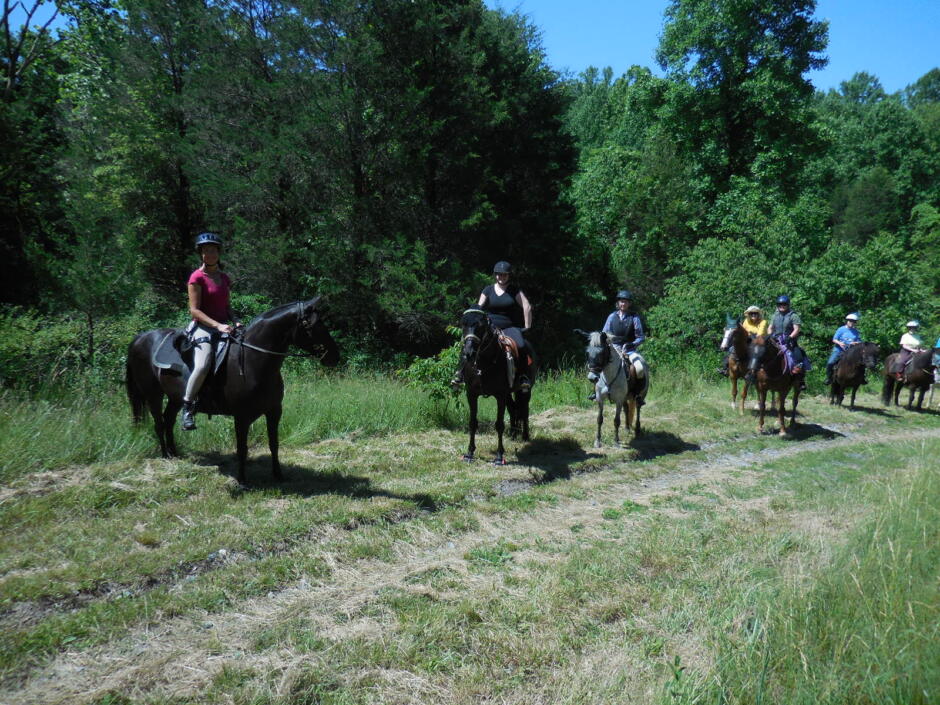by Katherine O. Rizzo (first published in the October 2022 Equiery)
Little Bennett Regional Park is nestled just a few miles from Interstate 270 and is spread over 3,700 acres, making it Montgomery County’s largest public park. The park features many camping options, a small playground, picnic areas, an 18-hole golf course, 14 historic sites and over 25 miles of multi-use trails. The park is open year-round from sunrise to sunset; but camping options and facilities are seasonal.
The trails at Little Bennett range from open fields to wooded areas and stream crossings, though the park is mostly forested. Little Bennett Creek and its tributaries run through the center of the park. Most of the trails are natural surfaces however there are areas where you may need to ride across asphalt or gravel parking areas. Montgomery County recognizes that these trails are enjoyed by many users and reminds people to yield the right of way as follows: Mountain bikes yield to all users; hikers yield to equestrian users.
There are 10 parking lots spread out across the park; of those, three are designated for trailer parking. The Prescott Road Horse Trailer Parking area is a meadow next to Prescott Road, which is off of Lewisdale Road. This lot has access to the Timber Ridge Trail, Dark Branch Trail and Pine Grove Trails. The Lewisdale Horse Trailer Parking area is directly off of Lewisdale Road and is a grassy parking area with access to the Lewisdale Trail. The third trailer parking area is on Frederick Road at the Day Use Area, which gives trail riders access to the Soper Branch Trail.
All trailheads and parking areas can be found at: https://montgomeryparks.org/resources/little-bennett-regional-park-trails-map/
For those looking for a bit of history, several trails lead to structures dating back to as early as the 18th century. The Little Bennett Valley was primarily an agricultural area, as well as hosting a small-scale timber industry. As with many other areas of Montgomery County, Little Bennett included plantations that used enslaved human labor during this time. Several grist mills, a sumac mill, a sawmill and bone mill, as well as a whiskey manufactory were once located along the Little Bennett Creek. Today, only the Hyattstown Saw and Grist Mill remains visible.
Around the close of the 19th century, a small rural community named Kingley, after the King family, was established within the valley. The one-room schoolhouse from that village still stands today and is open to the public on a limited basis.
Below is a list of historical sites found along Little Bennett’s trail systems. For more information on these sites, please visit: https://montgomeryparks.org/parks-and-trails/little-bennett-regional-park/h…
1. The Montgomery Chapel Cemetery: The burial ground for the former parishioners of the Montgomery Chapel, a small black Methodist Episcopal church that closed in 1964 and was subsequently demolished. The 1871 one-room chapel formerly stood to the west of the cemetery and served as a house of worship, community center and a school.
2. The Zeigler Log House: The log house at the back of the extant house was built in 1823 by Elisha Hyatt, son of the founder of Hyattstown, and housed several generations of the Zeigler family. The front frame portion of the house was built by David Zeigler after 1854. The Zeiglers used both slave and paid labor in the 1850s to 1870s for their agricultural and milling operations. (Not open to the public.)
3. Hyattstown Mill: Saw and grist milling activities took place at this location under various owners from the 1790s-1930s. In 1996 the exterior of the mill was restored to its circa 1910 appearance and functions as an art space and gallery operated by the Hyattstown Mill Arts Project, a Parks partner.
4. Hyattstown Miller’s House: The miller’s house adjacent to Hyattstown Mill predates the mill. Throughout its history until the 1930s, the house served as a residence for the mill owner or the miller. (Not open to public)
5. Zeigler’s Sumac Mill: Located a short ways east on Prescott Road, and crushed the red berries of the sumac weed which were then used in tanning leather. The water-powered sumac mill processed over 130 tons of the berries in 1850, and employed six men.
6. Zeigler’s Saw and Bone Mill: By the 1860s David Zeigler had transformed his water-powered milling operations to focus on timber and bone. The mill race is still intact and runs parallel with Hyattstown Mill Road. The only remnants are a stone wall and wheel pit.
7. The Charles Browning House: Built around 1850 by Charles Browning, this site is a good surviving example of a 19th-century Montgomery County farmstead with its collection of barns, a springhouse and other outbuildings. (Not open to public)
8. Wilson’s Mill: Owned by Lee Wilson in the mid-19th century, only faint traces of the mill remain.
9. The Kingsley Schoolhouse: The recently restored schoolhouse was constructed in 1893 after the community pushed for a school within walking distance of Little Bennett Creek Valley farms. It closed in 1935 when the local population began to decline and was replaced by a new schoolhouse in Clarksburg. (Open to the public for tours, events, and classes.)
10. Wims Meadow & Wims Negro Baseball Field: A major destination for local African-American residents who came to have picnics and watch various teams play sandlot games on Sundays throughout the summer. Games were fielded by local stars who sought to play professional baseball in the National Negro League. The property belonged to Jim Wims, who bought it for farming in 1919, but took some of his land out of acreage to provide a place for his sons to practice ball.
11. King’s Distillery: The former site of the King Distillery, producers of Maryland rye whiskey. It was built in the late 19th century and closed around 1907. In addition, the King’s operated a small cider and saw mill near this location.
12. Norwood Tobacco Barn Ruins: Dating from 1884 and built by Jeremiah Norwood to cure his tobacco crop. This site also once contained a barn, corn crib, and a farmhouse belonging to Norwood, a carpenter, millwright, and Confederate army veteran and his family.
MHC Trails Stewardship Committee Chair: Carolann Sharpe • blackandwhitecookieequine@gmail.com













